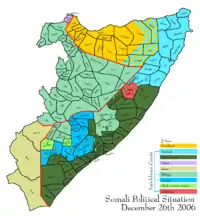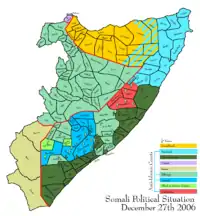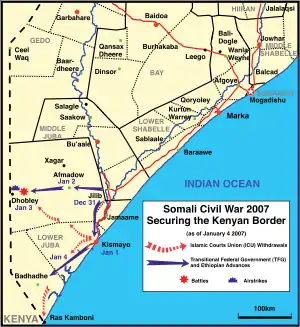Fall of Mogadishu
The Fall of Mogadishu occurred on December 28, 2006, when the Islamic Courts Union peacefully withdrew from Mogadishu. The army of Somalia's Transitional Federal Government (TFG) and Ethiopian troops entered the Somali capital unopposed.[1] The Ethiopian Invasion of Somalia continued until 2009.
Background
On December 24, Ethiopia admitted that its troops were fighting the Islamists, after stating earlier in the week that they had only sent several hundred military advisors to Baidoa. Heavy fighting erupted in border areas, with air strikes and shelling being reported. Eyewitness said Ethiopian troops bombarded the ICU-held town of Beledweyne.


On December 25, Ethiopian and TGF forces captured Beledweyne, with ICU forces fleeing Beledweyne at the same time Ethiopian fighter jets bombed two airports. Heavy fighting was also reported in Burhakaba.[2]
On December 26, the ICU was in retreat on all fronts, losing much of the territory they gained in the months preceding the Ethiopian invasion. They reportedly fell back to Daynuunay and Mogadishu.[3]
On December 27, Ethiopian and TFG forces were reported en-route to Somalia's capital, Mogadishu after capturing the strategic town of Jowhar, 90 km from the capital. The ICU were in control of little more than the coast. Islamist leaders evacuated many towns without putting up a fight. Also, the ICU top two commanders, defense chief Yusuf Indade and his deputy Abu Mansur were away on the Hajj pilgrimage in Mecca.[4]
Islamists disarm and Hawiye clan starts discussions with TFG on peaceful resolution
As fighting neared Mogadishu, the Islamists turned over their weapons to the clans in the capital and the Hawiye, one of Somalia's largest clans, began discussing a peaceful resolution with the TFG. [5]
Resignation of ICU Leaders
The top leaders of the ICU, including Sheikh Hassan Dahir Aweys, Sheikh Sharif Sheikh Ahmed and Sheikh Abdirahman Janaqow, resigned on 27 December 2006. [6]
Warlords attempt to rearm
The stability created by the Islamist militias began to collapse with bandits once again roaming the streets. Fighting began early on the 27th in Yaqshid, a district in northern Mogadishu, as clan militias attempted to raid an arms warehouse. The clan militias, who had been disarmed by the ICU, appeared to be attempting to rearm in preparation for the return of the warlords associated with the TFG.[7]
Most businesses had closed by the 28th December. Roughly 3,000 Islamists fled towards the port city of Kismayo, 300 miles (500 km) to the south. Former chairman of the Islamic Courts Union, Sheikh Sharif Ahmed, said the people were leaving Mogadishu "to avert heavy bombing because Ethiopian forces are practising genocide against the Somali people".[8]
After Mogadishu fell to the Ethiopian and TFG forces on December 28, fighting continued in the Juba River valley, where the Islamists retreated, to the city of Kismayo.
TFG takes Mogadishu
On December 29, Ghedi entered the city. While a crowd of TFG supporters cheered, thousands protested and some threw stones. Shots were fired into the air to quell the protests. [9]
Aftermath
Heavy artillary fire was reported on December 31 in the Jilib and the ICU causing the Islamists to once again go into retreat, abandoning Kismayo, without a fight, retreating towards the Kenyan border.[10]

The transitional government requested that Kenya seal its border with Somalia. [11]
See also
References
- Government troops take Somalian capital
- Ethiopia attacks Somalia airports BBC News
- Islamic forces retreat in Somalia CNN
- Ethiopians nearing Somali capital BBC News
- Somalia: Islamists hand over weapons to their clans Archived 2007-01-10 at the Wayback Machine, Somali Net.
- "Islamic Courts Union". Standford University.
- "Somalia: Mogadishu in chaos as Islamic militia leave", IRIN, 28 December 2006.
- Islamists abandon Somali capital. BBC, Thursday, 28 December 2006, 11:24 GMT.
- Mogadishu crowds greet Somali PM, BBC News, December 29, 2006.
- Farah, Mohamed Abdi (2007-01-01). "Somalia: Islamists lost their last strongholds". SomaliNet. Archived from the original on 17 January 2007. Retrieved 2007-01-01.
- "Somalia targets Islamists' escape". BBC. 2007-01-01. Retrieved 2007-01-01.